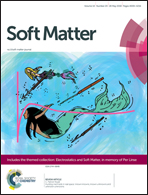Monte Carlo simulations of weak polyelectrolyte microgels: pH-dependence of conformation and ionization†‡
Abstract
In this study, we investigated the effect of pH on single weak acidic polyelectrolyte microgels under salt-free conditions with (i) varying microgel concentration, (ii) varying content of acidic groups and (iii) different crosslinking densities using Monte Carlo simulations under explicit consideration of the protonation/deprotonation reaction. We assessed both global properties, such as the degree of ionization, the degree of swelling and the counterion distribution, and local properties such as the radial network ionization profile and the ionization along the polymer chains as a function of pH. We found a pronounced suppression of the pH-dependent ionization of the microgels, as compared to the ideal titration behavior and a shift of the titration curve to a higher pH originating in the proximity of acidic groups in the microgel. In contrast to macroscopic gels, counterions can leave the microgel, resulting in an effective charge of the network, which hinders the ionization. A decreasing microgel concentration leads to an increased effective charge of the microgel and a more pronounced shift of the titration curve. The number of acidic groups showed only a weak effect on the ionization behavior of the microgels. For two different microgels with different crosslinking densities, similar scaling of the gel size was observed. A distinct transition from an uncharged and unswollen to a highly charged and expanded polymer network was observed for all investigated microgels. The degree of swelling mainly depends on the degree of ionization. An inhomogeneous distribution of the degree of ionization along the radial profile of the microgel was found.

- This article is part of the themed collection: Electrostatics and Soft Matter


 Please wait while we load your content...
Please wait while we load your content...